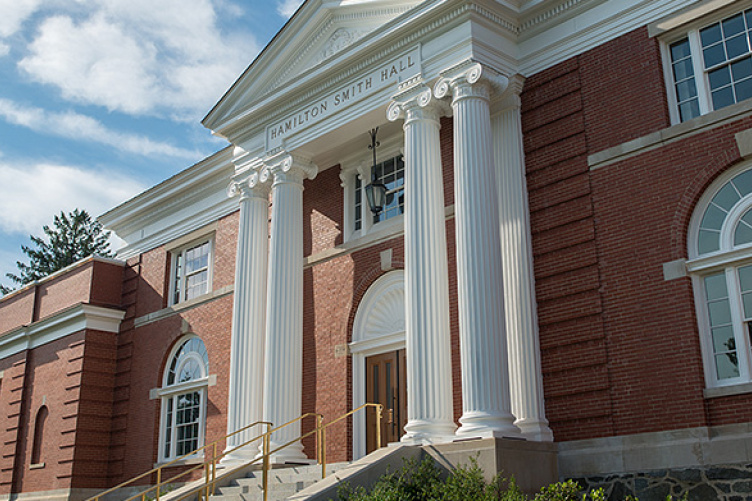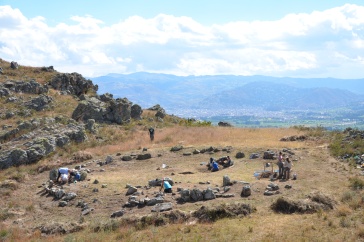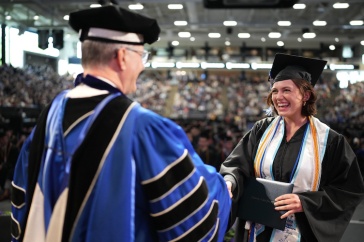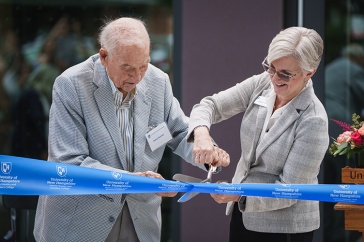
 Ribbon cutting at the Hamilton Smith Grand Reopening on September 22. (pictured l to r): Nick Smith, professor and chair of philosophy; Rachel Trubowitz, professor and chair of English; Mark Huddleston, president of UNH; Heidi Bostic, dean of the College of Liberal Arts; Reginald Wilburn, associate dean in the College of Liberal Arts; Brett Gibson, associate dean in the College of Liberal Arts. Photo by Jeremy Gasowski.
Ribbon cutting at the Hamilton Smith Grand Reopening on September 22. (pictured l to r): Nick Smith, professor and chair of philosophy; Rachel Trubowitz, professor and chair of English; Mark Huddleston, president of UNH; Heidi Bostic, dean of the College of Liberal Arts; Reginald Wilburn, associate dean in the College of Liberal Arts; Brett Gibson, associate dean in the College of Liberal Arts. Photo by Jeremy Gasowski.First-year students walking through the columns and up the steps of Hamilton Smith Hall are hardly aware of the building’s venerable history and complete transformation, although faculty and alumni continue to be in awe of its $37 million expansion and renovation.
Recently completed after two years of construction and now open to students and faculty, Ham Smith’s exterior and interior reflect architectural changes and technology advances that aim to better facilitate student learning and connect both students and faculty to one another.
Heidi Bostic, dean of the College of Liberal Arts, describes Ham Smith as an iconic building that represents considerable history for both COLA and the university as a whole. Originally built in 1907 as a Carnegie Library with a $10,000 starter donation from Hamilton B. Smith, Ham Smith underwent several renovations, its last in 1965. The building served as a library for more than 50 years, until Dimond Library was built in 1958, when it became an academic building.
Nestled on Main Street between Thompson Hall and the Memorial Union Building, Ham Smith is “the front porch of our campus,” says Bostic — a symbol of the values of a liberal arts education and critical to the mission of the University of New Hampshire.
“I think about all of the alumni and their legendary professors, like Don Murray, and their great memories of being in Ham Smith. I can’t wait to see the reactions of alumni when they see the renovation,” she said.
Bostic credits a comprehensive team of UNH staff and contractors — from faculty to building contractors to member of Facilities and technology staff — for their sense of pride in ensuring that every detail of Ham Smith passed muster before its grand re-opening.
“It's just incredible seeing the transformation — from touring the construction zone to seeing what it's become now," she said. "After I had finished a final walk-through, I was describing the new building to Provost Targett and was overcome by emotion just talking about it. I was thinking about this amazing facility's future impact on student learning. Having a beautiful, technology-rich space in which to learn makes such a difference.”
According to Kevin Sousa, academic counselor for COLA and chair of the building committee for Ham Smith, he is most proud of the greater accessibility and community that the new building fosters. The building expansion includes a bridge, which now connects Ham Smith to Thompson Hall, the Dimond Library and Murkland Hall, allowing students a greater ability to navigate the campus. Classrooms are equipped to facilitate students with mobility issues, and its indoor and outdoor common spaces truly make Ham Smith a “destination location,” in which students and faculty can informally gather, study and discuss.
WATCH VIDEO: Artist George Loyd’s mural, “Agriculture,” and “Industry,” painted by Arthur Esner were two Depression-era Works Projects Administration wall paintings that underwent restoration as part of the Hamilton Smith Hall expansion and renovation project. Video produced by Scott Ripley UNH Communications and Public Affairs
“I believe so strongly in building an environment that students can learn in,” Sousa said. “It’s such an important element in their learning experience.”
The external façade of the building retains its proud history, and an addition of 65,000 square feet provides more classroom seats and common space on the first floor. Two WPA murals in Ham Smith, dating back to the 1940s, were also restored to their original splendor. Art history graduate Corrine Long ’12 participated in the project, which was funded in large part by Peter T. Paul '67, whose godfather, George Lloyd, was one of the artists.
While the building remains true to its historical roots, it also looks toward to the future. Classrooms include two Technology-Enhanced Active Learning, or TEAL classrooms, that facilitate collaborative, technology-rich learning. These rooms allow faculty and students to share, collaborate and analyze one another’s work in small-group and whole-classroom settings. Newly-imagined lab spaces include the Donald Murray Journalism Lab, which boasts a soundproof editing room with a green screen, and a digital recording room. There is also a digital writing studio, a technical writing lab and a film screening room.
Bostic explains that the way faculty teach today not is not the same way students were taught when Ham Smith first opened. Today’s students have different needs and interests and use different technologies.
 Aerial view of the newly expanded and restored Hamilton Smith Hall. Photo by Jeremy Gasowski.
Aerial view of the newly expanded and restored Hamilton Smith Hall. Photo by Jeremy Gasowski.Hamilton Smith Expansion and Renovation: At a Glance
› Built in 1907, renovated in 1938 with two additions added in 1959 and 1965. The 1959 and 1965 additions as well as a portion of the original 1907 construction removed as part of this project.
› $37 million project cost
› 91,000 square feet (26,000 renovated and 65,000 added)
› 23 classrooms
› 6 conference rooms
› Great Hall and 7 lounge/study areas
› Two Technology-Enhanced Active Learning, or TEAL, classrooms
› New lab spaces: Donald Murray Journalism Lab, Digital Writing Studio, Technical Writing Lab
› Two painstakingly restored WPA murals
› Bridge that connects Hamilton Smith to Library Way
“While it’s the same core material that’s always been taught — the way and methods of delivery have changed,” Bostic said. “It’s like having the world at our fingertips right here in Durham. We are giving students the rich environment they deserve and love.”
Cristy Beemer, associate professor of English, remembers Ham Smith when it was dusty and faculty offices were hard to find and often inaccessible to students. Beemer is the coordinator of the technical writing program, which serves the entire campus, as students from other colleges — including CEPS and Paul College — are required to take courses as part of their programs.
“In this 21st century work, collaboration is the key,” Beemer said. “Hands-on learning is required to make deep learning happen.”
The digital writing studio is set up in U-shaped tables that are adjacent to the wall, where small groups of students can sit and discuss their work. At each table, a computer monitor is mounted on the wall, to which students can hook up their laptops and show their work.
“The most amazing piece is that you can stand at the teacher station, pull up a document (on the computer) and cast it on the projection screen in front of a whiteboard — and then write on it. Then, the computer can save what you’ve written,” Beemer said. “To be able to do that in front of the classroom and have students do it gives them that real-world experience and helps them become super prepared for work.”
Journalism professor Lisa Miller, who joined UNH in 1989, teaches in one of the TEAL classrooms. She said it’s useful to be able to project news stories up on the screens so that students can really see and hear — and then share their own work in small groups. She also said the editing room will allow students to create higher quality audio and video pieces to help craft more compelling stories.
“The technology doesn’t really change how I teach,” Miller said. “But because the furniture in the TEAL classroom is set up in pods, I can more easily have students do group work and I can consult with students while they are working.”
Miller, along with many of her colleagues, credits the new common spaces as some of the best features of the renovation. English and philosophy classes and faculty were spread across the campus for the past two years, without any place to share or call home — until now.
Philosophy professor and chair Nick Smith said he also enjoys the new communal spaces that allow students to gather near the faculty, bump into them, and have conversation before and after classes.
“In Nesmith, students just wanted to get out. Philosophy questions what we value and what matters. It’s important for that to be right at the center of campus — right at the hub of other things going on,” he said.
Subrena Smith, assistant professor of Philosophy, agrees.
“For me I like things that are older and have character, but there is no question that this (renovation) communicates to students that they matter. They are using the space and the energy is lighter — I think my own posture changes when I walk through the space and it’s wonderful.”
In addition to Peter Paul’s generous support of the mural restoration, other alumni have demonstrated their support of the Ham Smith renovation. Allen Miller ’72, recently made a gift to name a classroom in honor of his former teacher and mentor, retired Professor John Yount. Miller said he took creative writing classes as an English major with Yount back in the late 1960s and 70s and wanted to give back in some way.
"What I learned in Professor Yount's classes shaped the way I came to view the world. Drama, dilemma, paradox, fate — all of this and much more unfold each day before me — and I have the sense I would have spent a lifetime not knowing or missing sight of them had I not received an introduction from Professor Yount," Miller said. "I thought it right to honor his contribution by having a lecture hall named after him. And in doing so, in some general sense I hope to honor the contributions of all the fine professors at UNH who also have enriched the lives of their students over the years."
Alumni were invited to tour Ham Smith for themselves at the Hamilton Smith Grand Reopening earlier this month, and many contributed to a time capsule that was installed during the event, not to be opened for another 100 years.
“It was a great time to come together and a devotion to the core values of UNH,” said Bostic. “It was wonderful to have something so tangible to celebrate.”
You can make a lasting impact on the UNH campus.
-
Written By:
Krysten Godfrey Maddocks '96 | College of Liberal Arts | krysten.godfreymaddocks@unh.edu
-
Compiled By:
Susan Dumais '88 '02G | College of Liberal Arts















































 VIEW SLIDESHOW: Images from the Hamilton Smith Grand Reopening on September 22. Photos by Jeremy Gasowski.
VIEW SLIDESHOW: Images from the Hamilton Smith Grand Reopening on September 22. Photos by Jeremy Gasowski.

